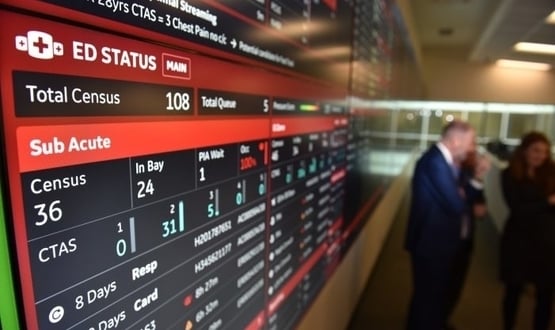Bradford Teaching Hospitals to scale ‘wall of analytics’ with new command centre
- 4 October 2018

Bradford Teaching Hospitals NHS Foundation Trust is to open a major new data ‘command centre’ designed to provide a real-time overview of patient flow and operational bottlenecks.
Designed by GE Healthcare, the command centre will be housed within a refurbished space at Bradford Royal Infirmary (BRI) and will draw data from multiple IT systems to help staff direct resources more effectively across the 800-bed hospital.
It is hoped the implementation will enable the trust to decrease length of stays, alleviate the need for additional beds and reduce cancellations for non-emergency surgeries.
Currently over 96% of bed capacity at BRI is used regularly and annual A&E attendances have increased more than 40% in the past 10 years.
Trust chief executive Professor Clive Kay said: “The command centre will enable us to optimise our use of resources and improve how we move patients around the hospital for treatment and successful discharge.”
GE Healthcare likened the command centre to that used by traffic control operators. Up to 20 staff will monitor a “wall of analytics” to identify problematic areas of care delivery and preempt bottlenecks before they occur.
The data will be displayed on high-definition screens with the command centre and will also be available to medical teams 24 hours a day on tablets and mobile devices.
GE Healthcare is responsible for delivering similar programmes in North America, including at Baltimore’s Johns Hopkins Hospital and at Humber River Hospital in Toronto, Canada.
According to the supplier, A&E wait times at Johns Hopkins have fallen by a quarter since it implemented its own command centre, while time spent waiting in the operating theatre for a post-surgical bed has decreased by 70%.
Mark Ebbens, European command centre lead at GE Healthcare, said: “Hospitals are increasingly looking to boost the efficiency of their operations so they can continue to deliver high quality care as patient volume increases.
“Command centres help to orchestrate the delivery of care across the organisation, bringing consistency to processes, prioritising actions, eliminating waste and predicting tomorrow’s pressure points.”
In June 2017, Digital Health News reported on Salford Royal NHS Foundation Trust’s plans to create a digital control centre.





5 Comments
£5.5m wow
Really interesting article and responses. However, there’s no mention of the cost or any expectation of how long it will take BRI to realise anything close to a 25% drop in A&E wait times and the 70% drop in post op beds… And, at the end of this, it will do little to address the Delayed Transfers of Care. Only broader visibility across multiple care settings is likely to assist here and that doesn’t look like part of the offering. Such a shame that UK SME’s with similar solutions don’t have access to the likes of Professor Clive Kay.
Irrespective of the data feed or the display the ‘command & control’ approach tends to work as seen in the ‘perfect week’ initiatives. The challenge is to implement the C&C structure and to make every week a ‘perfect week’.
The data will only be as up-to-date as the systems feeding this? Im not sure how quickly Staff update these systems but those bottlenecks may be historical by the time the data is assessed.
exactly…unless the integration with all the multiple systems where the data is held is in real time (Many of them wont even support that type of integration) some of the information will be out of date before it even gets to the display wall. There will definitely be a feeling out process to discover what works and what doesn’t but the idea is a great idea.
Comments are closed.